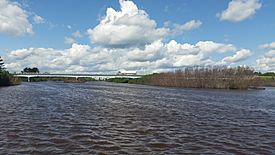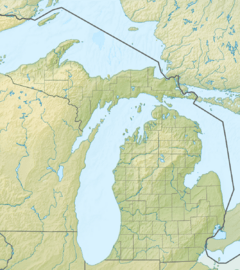Manistique River facts for kids
Quick facts for kids Manistique River |
|
|---|---|

U.S. Route 2 crossing the river in Manistique
|
|
|
Location within the state of Michigan
|
|
| Country | United States |
| State | Michigan |
| Region | Upper Peninsula |
| Physical characteristics | |
| Main source | Alger County, Michigan 46°14′49″N 85°51′07″W / 46.247°N 85.852°W |
| River mouth | Lake Michigan 45°56′53″N 86°14′46″W / 45.948°N 86.246°W |
| Length | 71 miles (114 km) |
| Basin features | |
| Basin size | 1,461 sq mi (3,780 km2) |
The Manistique River is a 71-mile long river in the U.S. state of Michigan. It flows south through the central Upper Peninsula. The river starts near Lake Superior and empties into Lake Michigan.
It drains about 1,461 square miles of the Upper Peninsula. This includes most of Schoolcraft County and parts of other counties. The river begins at Manistique Lake in Luce County. It then flows through the Seney National Wildlife Refuge. Finally, it reaches Lake Michigan at Manistique, Michigan. A highway called M-77 follows much of the Manistique River's path.
Contents
The River's Surroundings
The land around the Manistique River is very flat and sandy. The river does not have fast rapids or waterfalls. Instead, it gently winds through sand and silt. This material is moved and dropped by the river itself.
The forests in this area were among the last in Michigan to be clear-cut. This means all the old-growth trees were chopped down, even as late as the 1910s. After this, much of the land was left alone or became state and federal property. As of 2007, 93% of the area was covered in forests. These were mostly new trees like aspen and birch. More than half of the land (58%) is owned by the government. This includes the Seney National Wildlife Refuge, Hiawatha National Forest, and Lake Superior State Forest.
Lakes Connected to the River
Several important lakes are part of the Manistique River system. These include Indian Lake near Manistique. Also, Manistique Lake in the central Upper Peninsula is a major source. Two other lakes, North Manistique Lake and South Manistique Lake, also feed into the river. These lakes have boat ramps, making them easy to access.
Fun Activities on the River
The Manistique River is fairly slow and flat for most of its length. This makes it a great place for people who are new to canoeing or kayaking. It's also a popular spot for fishing. People often try to catch bass, pike, and walleye. There are also some trout in the river, which can be a fun challenge for anglers.
River Health and the Environment
Protecting the Great Lakes
A part of the Manistique River was named a Great Lakes Area of Concern (AOC). This happened because of pollution in the river. The AOC includes the last 1.7 miles of the river, below a dam in Manistique city. It also includes the Manistique harbor where the river meets Lake Michigan.
The riverbed here had high levels of harmful chemicals called PCBs and heavy metals. These came from old sawmills, a paper mill, and other small factories along the river. In 1996, a plan was made to fix these problems. It listed five main issues caused by the pollution:
- Fish and wildlife could not be eaten due to PCBs and heavy metals.
- The tiny creatures living on the river bottom were harmed. This was due to wood waste, factory waste, and sewage overflows.
- Dredging (removing mud from the river bottom) was difficult. This was because of high levels of PCBs and heavy metals like lead and copper.
- Beaches might need to close because of high bacteria levels from sewage.
- Fish and wildlife habitat was lost, especially for coldwater fish.
Good news! Three of these problems have been fixed. The issues with river bottom creatures, lost habitat, and beach closings were removed from the list. This happened after cleanup projects began in the 1990s. These projects included covering polluted areas and removing contaminated mud.
Dealing with Sea Lamprey
In 1996, a report said the Manistique River had the largest number of invasive sea lamprey in Lake Michigan. A 2007 study found it was the second-largest source of sea lamprey babies in the whole Lake Michigan area.
A dam built in 1919 in Manistique city used to stop lampreys from swimming upstream. But the dam has gotten old and doesn't work as well anymore. So, the U.S. Fish and Wildlife Service and other groups are planning to build a new barrier. This will help stop the sea lampreys from moving further up the river.



